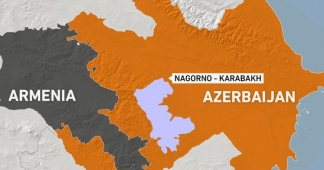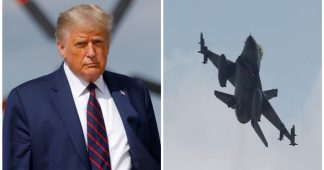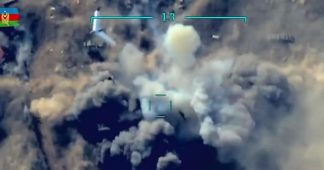The fighting in Karabakh shows a model of the war of the future
Azerbaijani drones play one of the most important roles during the offensive on Karabakh
October 8, 2020
Photo: mod.gov.az/ru
By Viktor Sokirko
The military actions taking place in Nagorno-Karabakh today are significantly different from the clashes that occurred here earlier. We are talking about the mass use of attack drones. Azerbaijan is using UAVs to test a model of combat operations against Nagorno-Karabakh, which in the future can completely change the picture of land combat in all future wars.
Azerbaijan reports daily on the destruction of numerous artillery installations, MLRS, air defense systems and other military equipment, especially tanks. The Armenian defense Ministry also reports on its large-scale successes. Each side shows video reports as confirmation of combat results. Such information, as usual, is overstated by each of the parties. Nevertheless, it is already obvious that in this still local war, a special place is occupied by unmanned aerial vehicles (UAVs). They determine the strategy and tactics of combat operations. Before our eyes, a kind of war of the future is being formed, when machines controlled from a distance go into battle.
Drones are now used in almost all the armies of the world. UAVs perform reconnaissance and strike functions, are capable of carrying various weapons or being used as a “guided missile” (another name is kamikaze drone). Their effectiveness was also demonstrated during the current conflict in Nagorno-Karabakh. Video footage distributed by Azerbaijan shows Azerbaijani army drones, mostly of Turkish and Israeli production, attacking Armenian tanks.
Yerevan has significantly fewer such video reports, although Armenia is also actively using UAVs. Armenia has 90 percent of its own production of UAVs – mostly light, reconnaissance class, while there are also attack UAVs, such as the Krunk-25-1 and its further modifications. The impact power is not so great, the “bomb load” does not exceed 15-20 kg of TNT equivalent, and the speed of this aircraft at maximum mode is 140 km/h. Armenia has several dozen of them, and they are theoretically able to destroy the enemy’s armored vehicles. However, the Armenian side prefers not to brag about drone victories. Apparently, because there are not so many of them. Military experts note that Armenia is significantly behind the Azerbaijani army in terms of the number and quality of drones.
And if Armenia mainly uses drones of its own production, the Azerbaijani army is mostly Israeli – Aerostar, Hermes, Heron, Harop, which is Orbiter 2M. And in addition, Turkish-made Bayraktar TV2 attack UAVs, which were captured on video during the attack on Armenian tanks. Their range is limited to 250 km, the “bomb load” is also not so high – something about 50 kilograms, which means two ATGM missiles or a kamikaze warhead that allows you to guarantee the destruction of one tank.
The cost of the Hermes strike drone is about $ 20 million, and the Orbiter 2M reconnaissance drone, which Azerbaijan has been actively using (and regularly losing) since 2016, is estimated at at least $ 600,000. It is known that Baku has spent $ 36 million on surveillance systems alone over the past few years. At the same time, the Russian T-90 tank, which is in service with both Armenia and Azerbaijan, draws only 4.5 million dollars. “Ramming” it is not exactly profitable, you just need to hit the target with a missile, which is significantly cheaper than a tank, and the drone itself can evade defeat.
Here again, Heron barrage projectiles (the launcher includes 20 missiles) equipped with optical or radar guidance systems are more economical. This “kamikaze drone” costs about 100 thousand dollars. Thus, a UAV worth one hundred thousand dollars can destroy a tank whose price is ten times higher. For the military, this is a very clear arithmetic in terms of the effectiveness of combat operations.
The war over Nagorno-Karabakh clearly demonstrated the effectiveness of the use of UAVs (previously they were successfully used during the armed conflicts in Syria and Libya), which once again indicates a change in the tactics of wars as such. “The sky is completely dominated by drones, and we see that they draw a line under the use of armored vehicles. It is completely defenseless in front of them, even with built-in dynamic protection. Today, tanks in the form in which they were, are beginning to go into the past, or, at least, designers need to draw serious conclusions,” military expert Alexey Khlopotov expressed his opinion on this.
The question involuntarily arises: why then all this thick armor, behind which the crew is hiding, which can be destroyed by a pinpoint and unpunished air strike?
It seems that the purpose of tanks as such is completely leveled. And if with Anti-tank weapons, artillery and other anti-tank weapons, armored vehicles are almost equal to the battle, then they become powerless against UAV attacks. First, because UAVs hit from above in the most unprotected places of the tank – in the thin upper armor of the tower and the engine compartment. Secondly, an unmanned aerial vehicle, although controlled remotely by a person, has some degree of artificial intelligence that allows you to identify the target, the ability to maneuver and ensure that the target is hit.
It turns out that the era of tanks as the main offensive weapon of the ground forces is over – and they can be scrapped?
“Any UAV is effective against tanks only if there are no means to protect the ground equipment itself from air attacks, – Alexey Leonkov, a military expert and editor of the magazine Arsenal of the Fatherland, shared his opinion with the newspaper VZGLYAD. – The drone itself is quite vulnerable to air defense due to its low speed and limited maneuverability. It can simply be shot down by portable anti-aircraft missile systems, or even from a large-caliber tank machine gun. It is enough for the drone to appear in the sight of the shooter, who, with appropriate training, is guaranteed to destroy it. It is another matter if the UAV is able to strike from a greater distance, as the Turkish Bayraktar does, but even then it has counteraction in the form of electronic warfare or anti-unmanned systems.
Neither of them is present in the armies of Azerbaijan and Armenia, as well as the defense army of Nagorno-Karabakh in proper numbers. Therefore, drones are shot down only with visual contact and, it is claimed, in a fairly large number, although the real numbers seem to be an order of magnitude lower. At the same time, their claimed effectiveness in defeating armored vehicles is also exaggerated, and a few video frames are more of a propaganda effect than a real result.”
Here you can recall the experience of countering drones by the Russian group in Syria. Attempts to attack the air base in Khmeimim are regularly carried out by militants, but all these air attacks are successfully repelled. Both means of fire destruction, and anti-unmanned means and electronic warfare systems. In particular, the “Pantsir S1” complex is used for fire suppression of UAVs, while other tasks are solved by silent radio – electronic “guns”. Among the most effective Russian means of electronic counteraction to small-sized UAVs can be called “Repellent”, “Sapsan-Snipe”, “Dome”, “Rubezh-Avtomatika”, “Luch” and “Pishchal”.
You can also recall the latest mobile laser system for fighting drones “Rat”, which was recently presented at the military-technical forum “Army-2020”. This system can be used directly on the battlefield – it is protected by armor and has a KAMAZ chassis, and is able to detect drones at a range of three to five kilometers at a speed of up to 200 km/h. To suppress the UAV’s radio-electronic equipment, microwave radiation is used that is effective within a radius of up to 2.5 km, and laser equipment that begins to operate at a distance of up to 1 km is used to physically destroy drones.
“The effectiveness of using UAVs to a greater extent applicable to intelligence activities, – the expert continues Alex Leonov. – Imagine a situation when a UAV detects a tank column moving towards the front line. If it attacks, it will destroy two or three vehicles and will be forced to either return to replenish the warhead, or will be shot down by return fire. If the fire is adjusted, either aviation or artillery will be able to bring much more benefit.
The prospect of widespread use of impact UAVs is still a prospect. Their use in Syria, Libya and now in Karabakh has shown that drones have a great future. In Russia, there are already special UAV units and training centers for relevant specialists.
As a means of defeating ground forces, we can now consider the Russian S-70 “Hunter”, which is at the testing stage, but is already learning to operate in tandem with the su-57 fighter. The American Reaper drone is already in use. At the same time, both are considered primarily as reconnaissance vehicles, and only then as shock. There are nuances here – the drone must be controlled by someone, especially at a distance of hundreds or thousands of kilometers. A ground operator is unlikely to cope with such a task, a staff control plane is needed, in our case it is the same su-57, which will direct the “Hunters” to the target.
In Nagorno-Karabakh, the use of UAVs is currently being tested, so to speak, and the effectiveness of their use is still inferior to the firepower of multiple launch rocket systems. At the same time, conclusions on their use should be made, including in Russia, and provide for the expansion of protection against drones.
Russia, unfortunately, entered the technological race to create modern drones too late. The same “Hunter” is just a test model, while the United States, Israel, and Turkey already have active strike vehicles. Now our country needs to work ahead of the curve – not just repeat Turkish or American developments, but create the UAVs of tomorrow.
The most important advantage of a UAV over a manned combat vehicle is its relative cheapness and mass production. Low-cost reconnaissance vehicles are now being adopted by the Russian army, but the Karabakh conflict has confirmed the need for an inexpensive unmanned strike system. And not one or two squadrons, but many hundreds of vehicles. Of course, all this implies not only funding, not only loading developers and industry, but also the emergence of a system for training qualified UAV operators. And in addition – a powerful system of drone controls in the interests of the Russian armed forces with all the necessary parameters in terms of noise immunity and reliability.
We can confidently say that the Russian General staff is studying the conflict in Karabakh with great attention. And first of all – from the point of view of the emergence of new methods of warfare using UAVs.
Published at https://vz.ru/world/2020/10/8/











